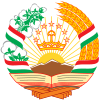Republik Sosialis Soviet Tajikistan
The Tajik Soviet Socialist Republic (bahasa Tajik: Республикаи Советии Социалистии Тоҷикистон, Respublikai Sovetii Sotsialistii Toçikiston; bahasa Rusia: Таджикская Советская Социалистическая Республика, Tadzhikskaya Sovetskaya Sotsialisticheskaya Respublika), also known as the Tajik SSR for short, was one of the 15 republics that made up the Soviet Union. Located in Central Asia, the Tajik SSR was created on 5 December 1929 as a national entity for the Tajik people within the Soviet Union. It succeeded the Tajik Autonomous Soviet Socialist Republic (Tajik ASSR), which had been created on 14 October 1924 as a part of the predominantly Turkic Uzbek SSR in the process of national delimitation in Soviet Central Asia. On 9 September 1991, Tajik SSR declared independence from the Soviet Union and was renamed the Republic of Tajikistan. After the dissolution of the Soviet Union, the state ceased to exist on 6 November 1994 with the adoption of the new Constitution of Tajikistan
Tajik Soviet Socialist Republic Таджикская Советская Социалистическая Республика Республикаи Советии Социалистии Тоҷикистон Respublikai Sovetii Sotsialistii Toçikiston | |||||||||
|---|---|---|---|---|---|---|---|---|---|
| 1929–1991 | |||||||||
 Location of the Tajik SSR (red) within the Soviet Union. | |||||||||
| Ibu kota | Dushanbea | ||||||||
| Bahasa yang umum digunakan | Tajik Russian | ||||||||
| Pemerintahan | Soviet Socialist Republic | ||||||||
| Sejarah | |||||||||
• Didirikan | 5 December 1929 | ||||||||
• Dibubarkan | 9 September 1991 | ||||||||
| Luas | |||||||||
| 1989 | 143.100 km2 (55.300 sq mi) | ||||||||
| Populasi | |||||||||
• 1989 | 5112000 | ||||||||
| Kode telepon | 7 377/379 | ||||||||
| |||||||||
| |||||||||
Bagian dari seri mengenai |
|---|
| Sejarah Tajikistan |
 |
| Garis waktu |
History
Bagian ini memerlukan pengembangan. Anda dapat membantu dengan mengembangkannya. (January 2011) |
One of the new states created in the process of national delimitation of Soviet Central Asia in October 1924 was the Uzbek Soviet Socialist Republic – Uzbek SSR or Soviet Uzbekistan. Soviet Tajikistan was created at the same time within the predominantly Turkic Uzbek SSR as an Autonomous Soviet Socialist Republic (Tajik ASSR) – one rank below a Soviet Socialist Republic in USSR geopolitical hierarchy. The new autonomous republic included what had been eastern Bukhara and had a population of about 740,000, out of a total population of nearly 5 million in the Uzbek Soviet Socialist Republic as a whole. Its capital was established in Dyushambe (today's Dushanbe), which had been a village of 3,000 in 1920. In December 1929, Tajik ASSR was detached from the Uzbek SSR and given full status as a Soviet Socialist Republic – Tajik SSR. At that time, its capital was renamed Stalinabad and the territory that is now northern Tajikistan (Sughd Province) was added to the new republic. Even with the additional territory, the Tajik SSR remained the smallest Central Asian republic.
With the creation of a Tajik republic defined in national terms came the creation of institutions that, at least in form, were likewise national. The first Tajik-language newspaper in Soviet Tajikistan began publication in 1926. New educational institutions also began operation at about the same time. The first state schools, available to both children and adults and designed to provide basic education, opened in 1926. The central government also trained a small number of Tajiks for public office, either by putting them through courses offered by government departments or by sending them to schools in the Uzbek SSR.
Under Soviet rule, the Tajik SSR experienced some economic and social progress. However, living standards in the republic were still among the lowest in the Union. Most still live in rural qishlaqs, settlements that were composed of 200 to 700 one-family houses built along a waterway.
References
- Tajikistan at the Library of Congress Country Studies.
- (Rusia) History of Tajik SSR, edited by B. A. Antonenko, Maorif Publ. House, Dushanbe, 1983.
External links
- Tajikistan, land of sunshine by Nazarsho Dodkhudoev.



